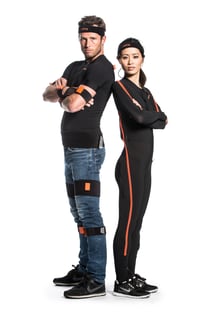Xsens MVN is an easy to use,
cost efficient
system that captures full-body human motion in any environment. It is based on small, unobtrusive inertial and magnetic sensors combined with advanced algorithms and
bio mechanical
models. In this blog
series
we will be looking at how some challenges in inertial motion tracking were overcome.

OVER the past decade, inertial motion capture has been used by a growing community and in a wide range of applications varying from character animation for movies, games, augmented reality and virtual reality, as well as human motion measurements for biomechanics, rehabilitation, ergonomics
and
sports.
Compared to alternative motion capture systems based on external emitters and/or cameras, inertial motion capture does not rely on any external infrastructure allowing it to be used anywhere. Despite this huge advantage over alternative motion capture systems,
inherent
drift of orientation (and position) in current solutions has prevented inertial motion capture systems to become a commodity.
Segment positions and orientations are typically estimated by applying the result of a sensor-to-segment calibration procedure to the corresponding sensor orientation
estimates,
and applying it to a (scaled) biomechanical model of the human body.
Errors introduced by three components. Each of these three components introduces errors that may affect performance, which will be individually discussed now.
- sensor-to-segment calibration is typically obtained by asking the subject to stand in a known pose (e.g. N-pose or T-pose) and estimating the sensor orientations by combining the sensor readings of the accelerometer (inclination) and magnetometer (heading), much like using a water level and a compass needle.
Specifically
the direct use of the magnetometer readings to obtain heading is a major source of
error,
since magnetic distortions or magnetometer calibration errors significantly affect the overall accuracy. Furthermore, the assumption of the subject holding a predetermined pose is likely to be (at least partly) violated, thus possibly leading to orientation errors that exceed 5 degrees.
- Individual sensor orientation is typically obtained by fusing the signals from the accelerometer, gyroscope, and magnetometer in a sensor fusion framework (e.g. complementary or Kalman filtering). Short-term changes in orientation are accurately tracked by the gyroscope, while the accelerometer and magnetometer provide longer-term stability. Accuracy depends on both sensor calibration and environment conditions. Inclination estimates can be distorted by long-term accelerations, while heading estimates can be corrupted by magnetic distortions, for instance from common materials in buildings (steel constructions, reinforced concrete, etc.), furniture, and electronic equipment in the surroundings. Despite the huge improvements in
accuracy
of single sensor orientation tracking, there are fundamental limits to the accuracy that can be obtained using gyroscopes, accelerometers, and magnetometers alone.
- The biomechanical model has limited accuracy when applied to a wide range of subjects. Imperfections in
scaling
of the model and inaccurate estimates of sensor locations on the segments are examples of error sources affecting the overall accuracy. In the past years, Xsens has spent tremendous efforts towards the creation of a new motion capture engine that aims at overcoming the major error sources of current solutions, in order to provide an accurate and consistent solution.
The new Xsens engine
The new engine combines the data of all motion trackers with advanced biomechanical models resulting in an immunity to the effects of magnetic distortions. In addition, the sensor to segment calibration procedure no longer relies on the data from the magnetometers, allowing the calibration to be performed anywhere. Finally, although the assumption of a known pose (N/T-pose) together with a predefined scaling model is still used in the current version of the engine, the current framework allows inclusion of customized models.
